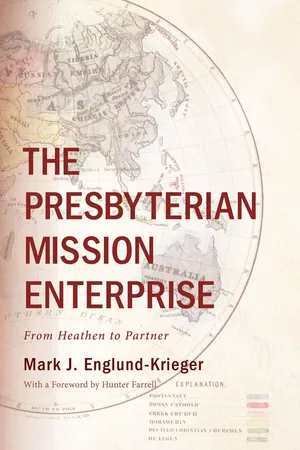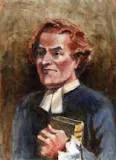Chapter 1
Francis Makemie
To begin at the beginning we must ponder a small group of rugged, devout and irascible pastors who first gathered in Philadelphia in 1706. Their gathering is considered the first organized meeting of the Presbytery of Philadelphia, the first presbytery in the United States. The pastors were all immigrants from England, Scotland or Ireland. They all understood their task as, to use Ashbel Green’s phrase, “a missionary enterprise.” Their circumstance was dire. Green described it this way: “They were, with a single exception, almost wholly destitute of property; and the people to whom they ministered, being like themselves in poverty, and struggling for subsistence in a wilderness land, could contribute but a pittance to the support of their pastors.” The bold tenacity of these first Presbyterian leaders and their faithful congregations are both remarkable.
With strong ties to the theological, ecclesiastical and ethnic traditions of their native lands these Presbyterians, nonetheless, claimed a new freedom and planted a new church in this land which was uniquely Presbyterian. It was a new thing. Writing his history of Presbyterian mission work in 1837, Ashbel Green expressed a deep amazement and respect for the original American Presbyterian missionaries and asks a discussion question which should echo through the ages since: “It may be questioned whether any missionaries, in more recent time, have made greater exertions to carry the gospel to the destitute, or have endured more hardships in doing it, than were exhibited by these venerable and devoted men.”
In his classic history of the Presbyterians, Lefferts Loetscher praised Francis Makemie.
Francis Makemie
Thus the ministry of Francis Makemie may be a moment in history on which we mark the start of Presbyterian mission work. Although a native of Ireland and with reputable Presbyterian instincts, Makemie’s ministry was supported by a cooperative effort, expressed in a Plan of Union in 1691, between Congregationalists and Presbyterians in England. Their institutional cooperation in England inspired the London Fund which sponsored Makemie as a missionary to America. In a massive, two volume, early history of Presbyterianism, Ezra Gillett starts with a chapter on Makemie praising his tenacious personality: “Indefatigable in effort, clear-sighted, and sagacious in his views, liberal in sentiment, fearless in the discharge of duty, and shrinking from no burden, his name needs no eulogy beyond the simple record of what he accomplished and endured.”
Although the physical travel across the Atlantic Ocean, in the small sailing ships of the day, was arduous the theological convictions and controversies skipped across the sea with ease. The great theological divisions within Protestantism which were now an intimate and centuries old aspect of the history of the England, Scotland and Ireland were all imported to America. Nonetheless the new freedom and the open space in America inspired some attempts at cooperation and compromise. But the ethnic differences and the power of theological convictions became boundary lines and soon also, theological controversies in this new land. Henry Wood, in an early history of the Presbyterians, sees a constant wavering between, on one hand, “jealousies, alienations and strifes” and, on the other hand, “correspondence and union.” Because of their close theological grounding it was the Presbyterians and the Congregationalists who created a sustained historical pattern of weaving together theological systems and thus consequent efforts at church cooperation which all were soon followed by their tearing apart again.
In the first century of the Presbyterian mission enterprise in America we will see a repeated refrain of both harmony with and antagonism between the Congregationalists and Presbyterians. As we know from the elementary folklore of American history, the Congregationalists, often named Puritans, were settled and influential in the New England states. “In 1701 Massachusetts had eighty-six ministers; and in 1713 Connecticut had forty-six churches which had been illumined by about ninety ministers. At that time, therefore, in the history of the American Church, the Congregationalists composed a much larger body than the Presbyterians.” From the first days of the Presbyterian mission enterprise both Presbyterians and Congregationalists were included in the budding structure of Presbyterian polity which was inspired by its English, Scottish and Irish forbearers but did not simply replicate those patterns.
The first Presbyterian churches were started as haphazard gatherings of frontier folk with church instincts from their motherland who joined in worship under the care of whichever Presbyterian pastor was in the vicinity. The first presbytery meeting included seven ministers representing both Presbyterians and Congregationalist churches, and several churches where that distinction was blurred. Francis Makemie was there under the sponsorship of the London Fund, a group of British Presbyterians sponsoring missionary work in America. The London Fund also sponsored two missionaries to accompany Makemie—John Hampton, an Irishman, and George McNish, a Scotchman. These three missionaries joined Jedidiah Andrews, John Wilson, Nathaniel Taylor and Samuel Davies who were already at work in Pennsylvania and Delaware in the spring of 1706 when the first meeting of a Presbytery in America was called. The Reverend Jedidiah Andrews was the first pastor of the first church of Philadelphia. These seven ministers who gathered voluntarily as the first presbytery are themselves a metaphor for American Presbyterianism which has always been both encouraged and stressed by the mixing together of different flavors of Reformed heritage. In historical reflection on this first gathering, Charles Briggs concluded: “It was a happy union of British Presbyterianism in its several types. It was an interesting combination. Makemie, the Scotch-Irishman; Hampton, the Irishman, and McNish, the Scotsman, sustained by funds provided by the Presbyterians in London; uniting with Puritan missionaries from new England in organic union in a classical presbytery. We have here in miniature the entire history of American Presbyterianism. It was a broad, generous, tolerant spirit which effected this union.”
Statue of Francis Makemie
The purpose of the first presbytery in America was focused and clear. These ministers were motivated to propagate their faith. The commitment to plant new congregations in this new land was their highest priority. Nonetheless, these were ministers who all cut their theological teeth in the great theological divisions and conflicts of Britain, Ireland and Scotland. This same culture of theological divisiveness was, of course, brought to America. Thus theological doctrine and the constant testing and evaluation of theological purity was an important and explicit purpose of the first presbytery. Makemie and Andrews emerged as leaders. Makemie’s reflections, in a letter after the meeting, of the design of that early presbytery is an important historic record reprinted in Charles Briggs’s history of this era:
The first American presbytery sustained a pattern of meeting annually for the purposes of strengthening the Presbyterian presence in this new land and “censuring” the pastors in their doctrinal convictions. These pastors were church planting missionaries and the new presbytery served as a launching pad for mission. The organization of the first presbytery was a brilliant institutional decision which immediately created a structure by wh...


